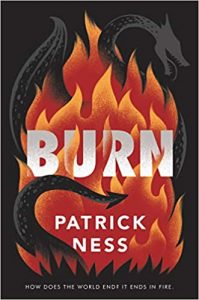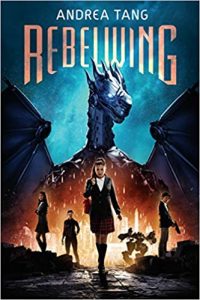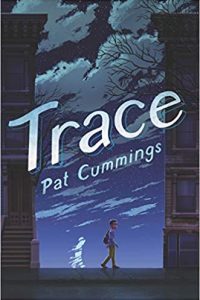Colleen Mondor Reviews Burn by Patrick Ness
 Burn, Patrick Ness (Harper Teen 978-0-06-286951-7, $18.99, 384pp, hc) June 2020.
Burn, Patrick Ness (Harper Teen 978-0-06-286951-7, $18.99, 384pp, hc) June 2020.
The first half of Patrick Hess’s thrilling alt-history, Burn, is set in a small rural Washington State town in 1957. Sarah Dewhurst and her father are barely holding their farm together, still mourning the recent death of Sarah’s mother and struggling to find a way to be a family without her. Gareth Dewhurst cannot afford the men he needs to clear his fields, so instead he has hired a dragon. It’s a risky endeavor – not exactly illegal but dangerous and frowned upon nonetheless. “They don’t have feelings to hurt any more than a wolf who would eat you for his breakfast,” he tells his daughter, “Just because the devil gave them the gift of speech doesn’t mean you’re talking to anything more than a mostly undomesticated predator.” Then why did we hire one, Sarah wonders? Why did you bring one to our home?
And why did it take the job?
As soon as readers accept that dragons are real in this mid-century America, they will quickly fall into the narrative. The dragon, Kazimir, makes clear to Sarah that he is there for reasons of his own and takes a peremptory interest in her wellbeing. Meanwhile, as a biracial teen with a best friend who is Japanese-American, Sarah has far more prosaic problems. The local deputy sheriff is a virulent racist who is determined to make her life a living hell:
He was the thing the world had suffered from most in her four billion years of existence: a stupid man with power. When the lights of the universe went out one day, standing over the plug, having pulled it despite all warnings, would be a man like Deputy Kelby, defiant in refusing to believe the advice of anything but his own sheer dumbness.
This is a world with flying dragons, but it is also our world in every way that matters.
As Sarah tries to figure out why Kazimir really came to Washington, the narrative splits to include a young man, Malcolm, who is a member of a dragon-worshipping cult and on a mission to save the world. There are also two federal agents hot on his trail, which leads straight to Sarah’s hometown, who are determined to stop him. This would all be interesting enough, the addition of crime detection to the already intense story, but then Malcolm is nearly captured and ends up being saved by another young man, one who is gay and running for his life from a particularly brutal home. It is this supportive character, Nelson, who knows nothing of dragons or dragon cults, who ends up changing everything, and because of him all the principals will meet on the road near Sarah’s farm and there, in a moment, the world will end.
Then the second half of Burn begins.
There may be some readers who will not like the dramatic shift, will find it too abrupt and, as a second world fills the pages with Sarah, Kazimir, Malcolm, and everyone else trying to figure out what is going on, they might wonder if Ness can pull this narrative trick off. Rest assured, the author knows exactly what he is doing and handles all the questions, large and small, with ease. He remains resolutely in actual 1957 for the second half, with all its dull little horrors, while inserting the flash and bang of fantasy. And he never resists a chance to make sure today’s teens see their value in these diverse characters, from Jason and Sarah, to Malcolm and Nelson, and also to exchanges with a dragon like this: “I’m just a girl,” says Sarah. “It is tragic how well you have been taught to say that with sadness rather than triumph,” replies Kazimir.
Print that on a hoody, please. Do it in bold.
Burn gives all the right nods to history while shaking things up at every turn. Patrick Ness has smart characters, powerful drama, and no small amount of fantastical moments. The dragon is the icing on the cake; I loved this one for all the wisdom, and also for the blink it gives us of what might have been.
Colleen Mondor, Contributing Editor, is a writer, historian, and reviewer who co-owns an aircraft leasing company with her husband. She is the author of “The Map of My Dead Pilots: The Dangerous Game of Flying in Alaska” and reviews regularly for the ALA’s Booklist. Currently at work on a book about the 1932 Mt. McKinley Cosmic Ray Expedition, she and her family reside in the Pacific Northwest and Alaska. More info can be found on her website: www.colleenmondor.com.
This review and more like it in the September 2020 issue of Locus.
 While you are here, please take a moment to support Locus with a one-time or recurring donation. We rely on reader donations to keep the magazine and site going, and would like to keep the site paywall free, but WE NEED YOUR FINANCIAL SUPPORT to continue quality coverage of the science fiction and fantasy field.
While you are here, please take a moment to support Locus with a one-time or recurring donation. We rely on reader donations to keep the magazine and site going, and would like to keep the site paywall free, but WE NEED YOUR FINANCIAL SUPPORT to continue quality coverage of the science fiction and fantasy field.
©Locus Magazine. Copyrighted material may not be republished without permission of LSFF.








